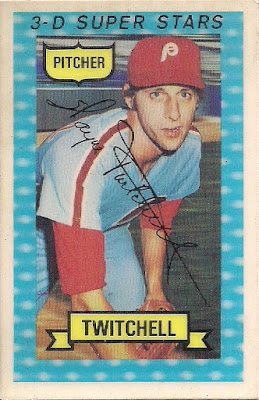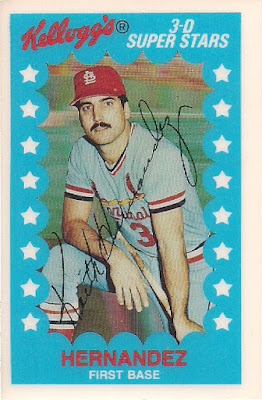I think I've done a pretty good job over the years explaining what I collect and exactly what I like about certain cards and certain sets.
But sometimes I wonder if I'm really doing that great of a job. Maybe I dwell on certain items more than others or maybe my posts drag on far too long. Whatever the reason, I just know that my collection just doesn't contain the right number of the right kinds of cards.
So I'm starting a "get to know me" series on this blog. Yes, more about me. Aren't you tingly all over? These will be posts in which I focus on a particular set or kind of card and explain exactly why I like them and do it probably in great detail. This way, you will know without a doubt that I want -- nay, neeeeed -- these cards and you will not be able to help yourself from showering them upon me.
Today's "get to know me" segment focuses on Kellogg's cards.
I would say that I am one of the bigger fans of Kellogg's cards in the card blogging world. If you believe that breakfast cereal makes a young kid grow then I quite literally grew up on Kellogg's cards. I can't help but love them. I am their target audience, and I've blogged about them a time or 12 or 18.
As I've also already said, I don't consider these cards "oddball". In the '70s, there was Topps and Kellogg's and Hostess and TCMA. They were all "just card sets," basically equal to each other. Nothing more odd than the other (except for those round discs that you got with ice cream or wiffle balls).
I still treat them as almost Topps' equal, as esteemed sets, yet, I can count the number of Kellogg's cards that I have received in trades on maybe two hands.
So, let's have a look at what I think of Kellogg's cards:
SIZE DOESN'T MATTER
Kellogg's issued its cards in all different widths -- from as wide as your average baseball card to the super narrow days of 1979 and 1980 (the Niekro is a 1979 card).
This doesn't matter to me. It did when I was a kid, but I've gotten over that now. I love them all equally. The ones from the '70s anyway (more on that later).
THE FIRST KELLOGG'S CARD I SAW WAS PROBABLY IN 1974
I can't tell you which card, or who exactly had it, but I do remember the blue, star-struck border vividly and the yellow badge and banner.
I DUG MY CARDS OUT OF A CEREAL BOX, DID YOU?
One of the great tragedies about growing up today or simply not growing up as a kid in the '70s, is you don't get to dig cards out of a cereal box anymore. Who knows the pure morningtime joy of shoving your arm up to the elbow into a box of Frosted Flakes and digging out a baseball card? I DO. I did it several times as a kid -- but first made sure that mom wasn't watching.
THE BACKS ARE AS GREAT AS THE FRONTS
Yes, the front featured "3-D" -- it said so right on the card -- but the backs featured full names (before Donruss), logos (before Fleer) and lengthy write-ups (before Score). Also, you think Studio was the first set to give an inside look into a player's interests? Nope, Kellogg's did that first. Ken Griffey -- excuse me -- George Kenneth Griffey -- likes drawing cartoons.
WHAT I THINK OF WHEN I THINK OF KELLOGG'S CARDS
To me, the 1978 Kellogg's set is the template for Kellogg's sets. It's quite possibly the brightest of all Kellogg's sets and the first one to put "Kellogg's" in script across the front of the card. I was at the peak of my awareness of Kellogg's cards in '78 -- I had fully realized just how wonderful they were -- and this set is first in my thoughts.
WHAT I THINK IS THE BEST KELLOGG'S SET
The 1976 bicentennial set sums up everything you want to know about Kellogg's sets, baseball in the mid-1970s and even life in the mid-1970s. I like this set so much that I plan to complete it some day. Heck, I'm already completing it in my mind.
I'M A KELLOGG'S CARD SNOB
I don't have a lot of use for mistreated Kellogg's cards. I do have several yellowed Kellogg's cards in my collection, obtained from a few different sources. They're not a pretty sight, especially when compared with the Kellogg's cards I've kept since childhood.
As a child, I didn't store my Kellogg's cards in any super safe place, but yet they managed to remain the same, for the most part, as the day I pulled them out of a cereal box or ordered them off the side of that box. I'd like all my Kellogg's cards to be that way. But I guess there's a price to pay for that.
CRACKED KELLOGG'S CARDS MAKE ME SAD
Kellogg's cards are delicate. I found that out at an early age. And as soon as I saw one crack, it had lost its use. It was a broken card.
People keep telling me "cracks give them character." I can't think that way about them. Card character I reserve for vintage sets from the '50s or earlier. They look good with character. Kellogg's cards don't.
Part of the magic of a Kellogg's card is the clear, smooth sheet over the player. A cracked sheet kills the pristine nature of a Kellogg's card. These were high-tech cards in the '70s. These photos to my kid way of thinking practically glowed beneath that transparent sheet. It was almost like holding a living entity in your hand. You had to protect it.
I HAVE NO IDEA HOW TO STORE KELLOGG'S CARDS
The mission, if you talk to Kellogg's card collectors, is to keep the cards from cracking. Well, how do you do that? I've heard all kinds of conflicting advice. "Keep them in pages in a binder", "Don't keep them in pages in a binder", "Keep them in toploaders", "Don't keep them in toploaders", "Keep them flat", "Let them curl". "Curling makes them crack," "They need to curl".
So I have my Kellogg's cards stores all different ways. My complete set of Dodgers are in toploaders (I'm happy to report, no cracking). Several other Kellogg's cards are in sheets in a binder (so far, so good). Others are in pages, but just lying in a box (one has cracked). I don't know if there is one perfect way for storing these things.
THE GLORY OF KELLOGG'S CARDS IS IN WHO THEY CHOSE
Most of the players in Kellogg's sets, which numbered between 40 and 60 cards, were stars. But not all of them. Wayne Nordhagen, Mario Guerrero and others appear in sets, making one wonder who they left out.
But I've never bothered to check who was left out. As a kid, I thought these were the chosen few, and if a player wasn't in the set, well they probably weren't chosen for a very good reason. They probably didn't eat Frosted Flakes. They deserved to be left out.
And that's the way I prefer to think of it still.
KELLOGG'S CARDS ARE A '70S PHENOMENON, MAN
Kellogg's put out sets in 1980, 1981, 1982 and 1983 and in the early '90s, too. But with the exception of 1980 -- which I still ordered off the side of a cereal box -- they are not equal in my eyes to the sets from the '70s.
"3-D Super Stars" is a '70s phenomenon. Yes, I won't turn away a Kellogg's card from 1982, but it can't possibly be as good as Kellogg's card from 1975.
KELLOGG'S CARDS STILL PRODUCE THE PURE JOY OF CHILDHOOD
When I look at Kellogg's cards, I think how I felt as a kid viewing them. They take me back to those weird, kid feelings.
You know how I just mentioned how handling a Kellogg's card was like handling a living entity? Did you read that sentence and think "What the hell is he talking about?" Well, that's because you're an adult, not a kid. Kids think of all kinds of weird things that make sense to them at that time because they're a kid. It's nice to be able to unearth those kinds of thoughts again as an adult.
Kellogg's cards do that for me.
And this is why I want all the Kellogg's cards.
Know it now?
Thanks for getting to know me.













Comments
And you're right about calling them "Oddballs." They were cards. Just like the others. Just like everything that comes in rectangular form and isn't super big (like those Donruss Action All-Stars). Now discs, those Topps 3D abominations from the 1980s, the candy containers from the early 1990s -- those are oddballs. Those Fleer boxed sets from the 1980s? Just cards.
Kelloggs have everything a modern set has, variations, stars, cool designs, and none of the annoying things like bloat, ugly photos, or short prints.
is what I'm missing. 1971 - P Blair(COR), D McNally(ERR), J Palmer(ERR); 1972 - J Palmer(ERR); 1975 - R Grimsley, B Grich(ERR), B Robinson; 1979 - M Flannigan(ERR); 1984 Do these
exist? I've seen Palmer & Stewart listed in one place, but can never find them.
johnfoxgerhardt@gmail.com